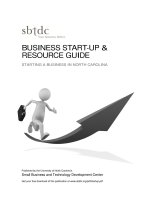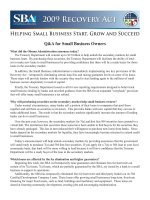Business start up and entrenuership
Bạn đang xem bản rút gọn của tài liệu. Xem và tải ngay bản đầy đủ của tài liệu tại đây (1.68 MB, 281 trang )
i
______________________________________________________________________________________
BUSINESS START-UP AND ENTREPRENEURSHIP
QCF Level 4 Units
• Understanding Entrepreneurship
• Enterprise Start-up
• Business Plan for Enterprise Start-up
(12 Credits)
(12 Credits)
(12 Credits)
Contents
________________________________________________________________________
Section
Title
Page
____________________________________________________________________________________________________________
Introduction to the Study Manual
v
Unit Specification (Syllabus) – Understanding Entrepreneurship
ix
Coverage of the Understanding Entrepreneurship Syllabus by the Manual
xix
Unit Specification (Syllabus) – Enterprise Start-up
xxi
Coverage of the Enterprise Start-up Syllabus by the Manual
xxix
Unit Specification (Syllabus) – Business Plan for Enterprise Start-up
xxxi
Coverage of the Business Plan for Enterprise Start-up Syllabus by the
Manual
xxxix
Chapters
1
Definitions of Entrepreneurship and Small Business
Definitions
The Importance of SMEs to National Economies
The Grey Economy
Differences Between Small and Large Businesses
1
2
6
9
11
2
Enterprise Theory and Concepts
The “Made or Born” Argument
Understanding Entrepreneurial Personalities, Attitudes and
Characteristics
The Family Support Argument
17
18
21
27
______________________________________________________________________________________
© ABE
ii
______________________________________________________________________________________
________________________________________________________________________
Section
Title
Page
____________________________________________________________________________________________________________
3
Entrepreneurial Motivation and Business Development
Business Life Cycles – Theory and Reality
Understanding Entrepreneurial Motivations
Barriers to Starting a New Business
Barriers to Growing a Small Business
Succession Planning and Exit Strategies
Encouraging Business Growth
33
34
36
38
40
43
48
4
Innovation, Creativity and Enterprise Cultures
Understanding Innovation and Creativity
The Innovation Spectrum
Innovative and High-growth-potential Technologies
Creating Innovative and Enterprising Cultures
53
54
61
63
67
5
Business Planning and Enterprise Start-up
The Importance of Business Planning
Expectations of Lenders and Investors
Business Plan Format and Structure
Planning and Funding High-tech and High-growth Start-ups
69
71
76
78
81
6
Enterprise Skills and Self-development
Knowledge and Skills Requirements for Business Start-up
Self-assessment of Skills and Abilities
Action Plans for Self-development
83
85
87
94
7
Developing and Presenting the Business Idea
The Business Idea Section of the Business Plan
Identifying the Target Customers
Researching and Evaluating Markets
97
98
101
104
8
Planning Physical Resources
Location, Premises and Space Requirements
Machinery, Equipment, Fixtures and Fittings
Purchasing and Supplies
Transport and Distribution
Security
113
114
118
121
126
128
______________________________________________________________________________________
© ABE
iii
______________________________________________________________________________________
________________________________________________________________________
Section
Title
Page
____________________________________________________________________________________________________________
9
Planning and Managing Staff Resources
Identifying and Planning Staff Requirements
Management Style
Motivating Staff
Potential Problems and Pitfalls in Staff Management
133
134
141
142
147
10
Developing the Marketing Plan
Strategies for Competitive Advantage
Developing a Coherent Marketing Plan
Customer Service and Quality Policies
Selling the Products or Services
155
156
158
165
170
11
Planning and Managing Business Finances
Budgetary Planning and Profit Forecasts
Working Capital, Cash Flow and Credit Control
Mark-up, Profit Margins and Break-even Analysis
Sourcing Finance for Start-ups
177
179
184
191
193
12
Legal and Financial Compliance
Trading Status Options
Identifying Relevant Legislation
Business Insurance
Intellectual Property Rights
197
199
205
217
219
13
Implementing the Start-up Process
Identifying Key Stages in the Implementation Process
Planning and Scheduling the Implementation
Risk Analysis, Risk Mitigation and Contingency Planning
Monitoring the Progress of the Business
227
228
231
233
235
______________________________________________________________________________________
© ABE
iv
______________________________________________________________________________________
______________________________________________________________________________________
© ABE
v
______________________________________________________________________________________
Introduction to the Study Manual
Welcome to the study manual for Business Start-up and Entrepreneurship. This is a
combined manual for the three Level 4 Entrepreneurship units: Understanding
Entrepreneurship (4UE), Enterprise Start-up (4ESU) and Business Plan for Enterprise
Start-up (4BP), the syllabus contents of which are closely related. The fourth unit,
Introduction to Marketing, has a separate recommended reading list on the Members Area
of the ABE website (www.abeuk.com).
This study manual has been developed for use by students who are studying ABE
qualifications in colleges and centres in some 70 countries around the world. Clearly, it
would be impossible to reflect the different cultures, legal and financial systems and
currencies of all of those individual countries within this manual. Therefore, for simplicity
and consistency, definitions of entrepreneurship and small and medium-sized enterprises
(SMEs) will be those used in the UK and European Union (EU), the currency used in
financial examples will generally be British pounds (£), and the examples of legislation
quoted will be based on English law. Tutors and students alike are encouraged to relate
the principles of these units to their own national currencies, and to consider examples of
their own national legislation.
Level 4 Diploma in Business Start-up and Entrepreneurship
The ABE Level 4 Diploma in Business Start-up and Entrepreneurship consists of four units
totalling 48 Credits on the Credit framework. Whilst the examinations for these units will all
be offered twice yearly, the Association of Business Executives strongly recommends that
students should take the Introduction to Marketing unit and the Enterprise Start-up units
before or alongside the Business Plan for Enterprise Start-up unit in order to cover the
necessary knowledge and understanding required for the latter unit examination.
Unit Titles
Introduction to Marketing (4IM)
Credits
12 Credits
Understanding Entrepreneurship (4UE)
12 Credits
Enterprise Start-up (4ESU)
12 Credits
Business Plan for Enterprise Start-up
(4BP)
12 Credits
Assessment
Three-hour
examination
Three-hour
examination
Three-hour
examination
Three-hour
examination
based on a
case study
It is intended that the Level 4 Business Start-up and Entrepreneurship units will provide a
combination of both practical and theoretical information. The theory learned from the
Understanding Entrepreneurship unit and the Introduction to Marketing unit provides the
broader knowledge of entrepreneurship. When linked to the more applied knowledge of
the Enterprise Start-up unit and the Business Plan for Enterprise Start-up unit, this will
______________________________________________________________________________________
© ABE
vi
______________________________________________________________________________________
provide the relevant knowledge and understanding for a student to prepare and start up a
new small business, or to work as a supervisor or junior manager within a small business.
This manual has been written to assist you in your studies for the Business Start-up and
Entrepreneurship Level 4 units (except Introduction to Marketing, which has a separate
recommended reading list), and is designed to meet the learning outcomes listed in the
syllabus for each unit. As such, it provides thorough coverage of each subject area and
guides you through the various topics you will need to study and understand. However, it
is not intended to “stand alone” as the only source of information in studying the units, and
we have set out below some guidance on additional resources that you should use for help
in preparing for the examination.
The syllabuses for each of the three units are set out on the following pages. They have
been approved at Level 4 within the UK’s Qualifications and Credit Framework. You
should read the three syllabuses carefully so that you are aware of the key elements of
each unit – the learning outcomes and assessment criteria. The indicative content
provides more detail to define the scope of the units.
Following each of the unit syllabuses is a breakdown of how the manual covers each of
the learning outcomes and assessment criteria for the units.
The main study material then follows in the form of a number of chapters as shown in the
contents. Each of these chapters is concerned with one topic area and takes you through
all of the key elements of that area, step by step. You should work carefully through each
chapter in turn, tackling any questions or activities as they occur, and ensuring that you
fully understand everything that has been covered before moving on to the next chapter.
You will also find it very helpful to use the additional resources (see below) to develop your
understanding of each topic area when you have completed the chapter.
Additional resources
•
ABE website – www.abeuk.com. You should ensure that you refer to the Members
Area of the website from time to time for advice and guidance on studying and on
preparing for the examination. We shall be publishing articles which provide general
guidance to all students and, where appropriate, also give specific information about
particular units, including recommended reading and updates to the chapters
themselves.
•
Additional reading – It is important you do not rely solely on this manual to gain the
information needed for the examination in these units. You should, therefore, study
some other books to help develop your understanding of the topics under
consideration. The main books recommended to support this manual are listed at the
end of the syllabuses on the ABE website and in the reading list on the Members
Area. Details of other additional reading may also be published there from time to
time.
•
Newspapers – You should get into the habit of reading the business section of a
good quality newspaper on a regular basis to ensure that you keep up to date with
any developments which may be relevant to the subjects in these units. Most of the
______________________________________________________________________________________
© ABE
vii
______________________________________________________________________________________
main international daily newspapers and weekly or monthly business journals can
also be accessed via the internet.
•
Your college tutor – If you are studying through a college, you should use your tutors
to help with any areas of the syllabus with which you are having difficulty. That is
what they are there for! Do not be afraid to approach your tutors for this unit to seek
clarification on any issue, as they want you to succeed in your studies.
•
Your own personal experience – The ABE examinations are not just about learning
lots of facts, concepts and ideas from the study manual and other books. They are
also about how these are applied in the real world, and you should always think how
the topics under consideration relate to your own work and to the situation in your
workplace and others with which you are familiar. Using your own experiences in this
way should help to develop your understanding by appreciating the practical
application and significance of what you read, and make your studies relevant to your
personal development at work.
And finally …
We hope you enjoy your studies and find them useful, not just for preparing for the
examination, but also in understanding the modern world of business and enterprise, and
in developing your own job role. We wish you every success in your studies for the ABE
Level 4 Diploma in Business Start-up and Entrepreneurship.
The Association of Business Executives
January 2013
Please note: Every effort has been made to trace copyright holders and obtain their permission for
use of copyright material. The publisher will gladly receive information enabling them to rectify any
error or omission in subsequent editions.
______________________________________________________________________________________
© ABE
viii
______________________________________________________________________________________
______________________________________________________________________________________
© ABE
ix
______________________________________________________________________________________
Unit Specification – Understanding Entrepreneurship
________________________________________________________________________
Unit Title: Understanding Entrepreneurship
Guided Learning Hours: 100
Level: Level 4
Number of Credits: 12
______________________________________________________________________________________
Learning Outcome 1
The learner will:
Understand the concepts of entrepreneurship and enterprise, and the
characteristics that differentiate the various types of entrepreneurs
and business owners, and the importance of entrepreneurs and SMEs
to the economy.
Assessment Criteria
Indicative Content
The learner can:
1.1 Define and explain
the terms:
entrepreneurship,
entrepreneurs,
enterprise and ownermanagers.
1.1.1 Define and explain the meanings of
entrepreneurship and enterprise and the various
forms these can take.
1.2 Explain and
discuss the importance
of entrepreneurship
and small businesses
to the economy.
1.2.1 Explain the role and characteristics of micro-,
small and medium-sized businesses in the economy
in terms of relative size, turnover, number of
employees, value of turnover, role in national
economies, etc, using the EU (or alternative)
definitions of these businesses.
1.1.2 Identify the differences between entrepreneurs,
serial entrepreneurs, intrapreneurs and ownermanagers – growth objectives, ability to identify
opportunities, attitude to innovation and risk, strategic
vision.
1.2.2 Explain the importance of business start-ups
and small firms to the economy – sources of
innovative products and services, generating new
employment opportunities, wealth creation and
revenue from taxation of profits.
______________________________________________________________________________________
© ABE
x
______________________________________________________________________________________
1.3 Identify and
explain the key
differences between
small businesses and
large corporations.
1.3.1 Explain the differences and relevance of those
differences between small and large firms in terms
of:
• structure and management
• organisational culture
• financial complexity and access to funding
• skills requirements
• attitude to staff training and development
• the ability to manage red-tape and legal
compliance
• the ability of small firms to be flexible and
respond rapidly to market demand.
Learning Outcome 2
The learner will:
Understand characteristics and motivations that influence the way
entrepreneurs operate, and the specific skills they use to succeed.
Assessment Criteria
Indicative Content
The learner can:
2.1 Identify the range
of skills typically
exhibited by
successful
entrepreneurs.
2.1.1 Describe the combination of entrepreneurship
skills that typify entrepreneurs or differentiate them
from other business managers – opportunity-spotting,
developing networks, strategic vision, product
commercialisation, ability to harness resources,
tenacity, etc.
2.1.2 Describe several examples of successful
international entrepreneurs to illustrate how the skills
are employed, for example: Richard Branson (Virgin),
Bill Gates (Microsoft), James Dyson (Dyson), Anita
Roddick (The Body Shop), Michael Dell (Dell), Alan
Sugar (Amstrad), Duncan Bannatyne (Dragons’
Den), Mo Ibrahim (Celtel), Wale Tinubu (Oando Plc).
2.2 Explain and
discuss key
arguments and
interpretations relating
to entrepreneurial
personality and
characteristics.
2.2.1 The key arguments.
• Are entrepreneurial skills inborn in certain
people? (The “made or born” argument.)
• Can entrepreneurship be taught or learned? Is
it a transferable management skill?
• Does growing up in an entrepreneurial
environment influence the potential to be
entrepreneurial?
2.2.2 Characteristic traits of owner-managers.
______________________________________________________________________________________
© ABE
xi
______________________________________________________________________________________
•
•
•
•
The need for achievement.
The need for independence.
The locus of control (believe you can exercise
control over your environment).
The ability to live with uncertainty and take
measured risks.
2.2.3 Characteristic traits of entrepreneurs.
• Opportunistic.
• Innovative.
• Self-confident.
• Proactive and self-motivated.
• Visionary with flair.
• Willingness to take far greater risks and live
with greater uncertainty.
2.2.4 Entrepreneurial motives.
• Push (necessity-based) motives vs pull
(opportunity-based) motives.
• Personal/lifestyle motives – desire to prove
personal ability or achievement/make a
mark/create personal wealth/gain social
recognition or prestige/create a legacy for
family future/competitive instincts.
• Desire to develop and grow a strong and
profitable business or business empire.
• Desire to minimise unbalanced risk/dislike of
imposed
authority/desire to prove oneself.
2.3 Explain and
discuss the concept of
the need for family
support to ensure
survival of a new
business.
2.3.1 Explain the family support argument.
• The pros and cons of the argument that the
strategic objectives of the business and the
objectives of the family (or families)
associated with the business must be aligned
if the business is to succeed.
Learning Outcome 3
The learner will:
Understand the various barriers faced by entrepreneurs when starting
a new business or when growing an existing small business.
Assessment Criteria
Indicative Content
The learner can:
3.1 Identify and
explain the barriers to
3.1.1 Describe and explain the various barriers that
entrepreneurs may experience when starting a new
______________________________________________________________________________________
© ABE
xii
______________________________________________________________________________________
business start-up.
business, including:
• Barriers relating to the entrepreneur’s own
skills, knowledge and abilities, competence
and confidence to successfully establish a
new business.
• Sales and marketing problems, including
issues of researching and understanding
markets.
• Financial problems, including identifying and
accessing appropriate forms of finance for
start-up, and the need for possible security
against borrowing.
• Resource implications for the business,
including both staff and physical resources.
• Identifying essential issues of statutory and
legal compliance, or registrations needed to
operate the business.
3.1.2 Describe and explain the options an
entrepreneur might have to overcome these
barriers.
3.2 Identify and
explain the barriers to
growing an existing
small business.
3.2.1 Describe and explain the various barriers that
entrepreneurs may experience when expanding a
small business, including:
• barriers relating to the entrepreneur’s own
financial position, renewed exposure to
financial risk, or the need to give up some
personal control in order to delegate to and
trust new functional managers
• barriers to market entry, including the size of
the market, problems of market penetration,
numbers and relative strength of competitors,
and costs of achieving market share
• financial problems, including identifying and
accessing appropriate forms of finance to
fund each stage of the growth, especially for
innovative/high-tech businesses
• resource implications for the business,
including expansion of both staff and
physical resources
• organisational issues relating to the impact
that growth strategies may have on the
existing staff and the culture within the
business.
3.3 Identify and
explain the
3.3.1 Explain the meaning and the key features of
enterprise cultures and how an organisation can
______________________________________________________________________________________
© ABE
xiii
______________________________________________________________________________________
importance of creating
an innovative or
enterprising culture to
support small
business growth.
benefit from creating such a culture.
3.3.2 Describe the ways in which an entrepreneur
might seek to create an enterprising culture within a
business, including:
• encouraging suggestions from staff for new
ideas or innovations
• allowing time and resources for staff to work
on new ideas
• creating a positive, supportive and blame-free
environment in which staff feel valued
• accepting failure as an acceptable risk, as a
normal part of the process and without any
blame
• building innovation targets into the staff
appraisal process
• acknowledging or rewarding successful ideas.
Learning Outcome 4
The learner will:
Understand the entrepreneurial motivations and influences that will
affect the ways in which a small business might develop and grow.
Assessment Criteria
Indicative Content
The learner can:
4.1 Define the
traditional concept of
the business life cycle
and its inherent
weaknesses in
explaining how
businesses develop.
4.1.1 Explain the five-stage linear business lifecycle model and why it is unsatisfactory in the
context of options for growth and development of
small businesses.
4.1.2 Describe and explain the various growth and
development options that a small firm might follow,
including:
• failure to survive the start-up stage, and
voluntary or involuntary closure
• achievement of break-even and profitable
trading levels and continuation as a lifestyle
business without subsequent growth
• continuation as a family business via
succession planning
• achievement of break-even and profitable
trading levels and continuation to grow to
maturity and decline
• achievement of break-even and profitable
trading levels and continuation to grow
further
______________________________________________________________________________________
© ABE
xiv
______________________________________________________________________________________
•
•
•
trade sale/merger/acquisition by another
company, or a pre-defined exit strategy
stock market flotation
continued expansion and success.
4.2 Explain and
discuss how the
entrepreneur’s own
objectives and
motivations will
change at each stage
of business
development.
4.2.1 Explain how the personal objectives, business
priorities and decision-making processes of
entrepreneurs change as they progress from startup to relative stability and subsequent growth.
4.3 Explain and
discuss the
importance of
succession planning
in small firms.
4.3.1 Explain the purpose and process of
succession planning in business, and in particular in
family firms.
4.4 Explain and
discuss the
importance of exit
strategies for
entrepreneurs.
4.4.1 Explain what is meant by exit strategies and
why it may be important for an entrepreneur to
identify exit options in the early stages of planning a
new business.
4.2.2 Explain the importance of strategic thinking to
the development of growth strategies in small firms
– as a factor that differentiates growth-firms from
lifestyle businesses.
4.3.2 Explain and describe the problems that can
occur relating to succession planning in small firms.
4.4.2 Describe some of the exit strategy options
available to entrepreneurs (or investors in small
firms), including:
• trade sale to another company
• sale of the company equity to an external
investor to facilitate future growth
• sale to a management buy-out
• closure of the business and sale of assets.
Learning Outcome 5
The learner will:
Understand the concepts of innovation and creativity, their importance
to the economy, and the roles that both play in entrepreneurship and
business development.
Assessment Criteria
Indicative Content
The learner can:
______________________________________________________________________________________
© ABE
xv
______________________________________________________________________________________
5.1 Define and explain
the terms innovation
and creativity.
5.1.1 Define the meaning of innovation and creativity
and explain how they interrelate.
5.1.2 Describe the different aspects of innovation that
comprise the innovation spectrum and explain the
importance of breakthrough innovations in creating
competitive advantage for businesses.
5.2 Explain and
discuss the
importance of
encouraging
technological
innovation and highgrowth-potential
enterprises.
5.2.1 Explain the importance of high-tech and highgrowth firms as contributors to economic wealth and
the creation of new employment opportunities.
5.2.2 Explain the different requirements that highgrowth and high-tech enterprises have compared with
conventional lifestyle businesses – specialist
management teams, support for research and
development (R&D), staged funding for growth.
5.2.3 Explain why high-tech businesses often need to
access several stages of funding in order to grow –
e.g.
• R&D funds
• proof of concept funding
• pre-market product development and patenting
• market launch
• seed funding for growth
• venture capital for expansion etc.
5.2.4 Explain how business incubation and support
programmes can improve the potential for highgrowth and high-tech start-ups to succeed and grow.
5.3 Explain the
importance of
protecting intellectual
property (IP) for
innovations.
5.3.1 Describe the main types of property rights
protection.
• Patents.
• Patent licensing.
• Copyrights.
• Trade marks.
• Brand names.
• Industrial and commercial secrets.
5.3.2 Explain some of the limitations of intellectual
property rights (IPR) protection and why some
entrepreneurs adopt a straight-to-market strategy.
• Concern that competitors may copy a patent
application.
• Expensive, time consuming and requires
______________________________________________________________________________________
© ABE
xvi
______________________________________________________________________________________
specialist legal expertise.
Even 20 years’ protection may be insufficient
to generate a satisfactory return on R&D costs.
Patents (and copyrights etc) are only meaningful if
they can be successfully defended.
•
Learning Outcome 6
The learner will:
Understand the political and economic issues facing entrepreneurs
and government support agencies, and identify the range of business
support processes that governments may offer to encourage and
support entrepreneurial development.
Assessment Criteria
Indicative Content
The learner can:
6.1 Define and explain 6.1.1 Describe and explain some of the political and
the political and
economic issues that impact on the operations of
economic factors that small businesses.
can influence the
• The conflicting need for regulatory controls
success of small
and the disproportionate impact this has on
enterprises.
the resources of small firms.
• The tendency of governments to regard
small enterprises as the solution to economic
downturns, whilst simultaneously cutting
back on support services for those
businesses when they are most needed.
• The lack of continuity of business support
caused by changes in national and regional
government.
• The lack of coherent funding support, e.g. for
start-up grants, market research, and skills
training.
• The lack of affordable finance and loans for
small firms due to the reluctance of
commercial banks to lend to them.
6.2 Explain and
discuss ways in which
new and early stage
enterprises can be
encouraged and
supported.
6.2.1 Identify and explain ways in which
governments can create the right environment and
fiscal conditions to encourage the development and
growth of new enterprises.
• Availability of business support expertise.
• Access to loans and investment funding.
• Enterprise-friendly taxation policies.
• Tax incentives to encourage risk investment.
• Start-up loans and grants for innovation
______________________________________________________________________________________
© ABE
xvii
______________________________________________________________________________________
•
•
•
development.
Encouraging collaboration with academic
research.
Encouraging development partnerships with
larger businesses.
Supporting international market access and
export trade development.
6.2.2 Identify and explain the main types of
business support agencies used by small firms, e.g:
• chambers of commerce
• local enterprise agencies and partnerships
• economic development agencies (public or
private sector)
• inward investment agencies
• international trade agencies and overseas
embassies
• export documentation and export credit
services
• private commercial banks.
6.3 Define and explain
the issues relating to
individuals and small
enterprises that
operate in the grey
economy.
6.3.1 Describe the potential attractions and pitfalls of
operating illegal part-time or full-time business
activities without being registered as a business –
avoidance of paying taxes or complying with legal
regulations etc.
6.3.2 Describe and explain the problems faced by
governments with illegal or unregistered individuals
and small firms operating in the grey economy – lack
of regulation and control, risk of unsafe or dangerous
practices, loss of taxation to the economy, no
recompense for unsatisfied customers, etc.
Assessment:
Assessment of this Unit will be by a three-hour examination.
Recommended Reading:
Please refer to the Qualifications section and the Members Area of the ABE website
(www.abeuk.com) for lists of recommended reading books.
______________________________________________________________________________________
© ABE
xviii
______________________________________________________________________________________
______________________________________________________________________________________
© ABE
xix
______________________________________________________________________________________
Coverage of the Understanding Entrepreneurship Syllabus by
the Manual
Learning Outcomes
Assessment Criteria
Manual
Chapters
1. Understand the
concepts of
entrepreneurship and
enterprise, and the
characteristics that
differentiate the
various types of
entrepreneurs and
business owners, and
the importance of
entrepreneurs and
SMEs to the
economy
1.1 Define and explain the terms:
entrepreneurship, entrepreneurs,
enterprise and owner-managers
1
1.2 Explain and discuss the importance of
entrepreneurship and small businesses
to the economy
1, 4
1.3 Identify and explain the key differences
between small businesses and large
corporations
1
2. Understand
characteristics and
motivations that
influence the way
entrepreneurs
operate, and the
specific skills they use
to succeed
2.1 Identify the range of skills typically
exhibited by successful entrepreneurs
2, 6
2.2 Explain and discuss key arguments and
interpretations relating to entrepreneurial
personality and characteristics
2, 3
2.3 Explain and discuss the concept of the
need for family support to ensure
survival of a new business
2
3. Understand the
various barriers faced
by entrepreneurs
when starting a new
business or when
growing an existing
small business
3.1 Identify and explain the barriers to
business start-up
3
3.2 Identify and explain the barriers to
growing an existing small business
3
3.3 Identify and explain the importance of
creating an innovative or enterprising
culture to support small business growth
3, 4
4. Understand the
entrepreneurial
motivations and
influences that will
affect the ways in
which a small
business might
develop and grow
4.1 Define the traditional concept of the
business life cycle and its inherent
weaknesses in explaining how
businesses develop
3
4.2 Explain and discuss how the
entrepreneur’s own objectives and
motivations will change at each stage of
2, 3
______________________________________________________________________________________
© ABE
xx
______________________________________________________________________________________
business development
4.3 Explain and discuss the importance of
succession planning in small firms
3
4.4 Explain and discuss the importance of
exit strategies for entrepreneurs
3, 4
5. Understand the
concepts of
innovation and
creativity, their
importance to the
economy, and the
roles that both play in
entrepreneurship and
business
development
5.1 Define and explain the terms innovation
and creativity
4
5.2 Explain and discuss the importance of
encouraging technological innovation
and high-growth-potential enterprises
1, 4
5.3 Explain the importance of protecting
intellectual property (IP) for innovations
12
6. Understand the
political and
economic issues
facing entrepreneurs
and government
support agencies,
and identify the range
of business support
processes that
governments may
offer to encourage
and support
entrepreneurial
development
6.1 Define and explain the political and
economic factors that can influence the
success of small enterprises
1, 3, 4
6.2 Explain and discuss ways in which new
and early stage enterprises can be
encouraged and supported
3
6.3 Define and explain the issues relating to
individuals and small enterprises that
operate in the grey economy
1
______________________________________________________________________________________
© ABE
xxi
______________________________________________________________________________________
Unit Specification – Enterprise Start-up
________________________________________________________________________
Unit Title: Enterprise Start-up
Guided Learning Hours: 100
Level: Level 4
Number of Credits: 12
_______________________________________________________________________
Learning Outcome 1
The learner will:
Understand that creativity is a central component of true
entrepreneurial activity; what makes an individual creative; the
barriers to creativity and the creative process.
Assessment Criteria
Indicative Content
The learner can:
1.1 Explain the
importance of
creativity to the
entrepreneur.
1.1.1 Understand that creativity is important in
coming up with new ways of doing things.
• The need for entrepreneurs to focus on
creating commercial opportunities leading to
new products/services.
• Be aware that out of every 11 ideas only one
will be successful (Page1993).
• The more ideas generated, the more chance
of success.
1.2 Explain how
creativity can be
stimulated.
1.2.1 Understand how the two sides of the brain
operate in different ways.
• Understand that the left side of the brain
tends to be rational/logical or vertical
thinking and the right side tends to be more
creative and lateral thinking.
• Understand that both sides of the brain are
used but there is a need to encourage the
development of the right side to encourage
creativity.
• Creativity can be encouraged with training.
1.3 Explain the
1.3.1 Understand and explain the main barriers to
______________________________________________________________________________________
© ABE
xxii
______________________________________________________________________________________
barriers to creativity.
creativity.
• Explain that being creative often takes
individuals out of their comfort zone.
• Be aware that many people find change
threatening.
• Von Oech (1998) identifies ten blocks to
individual creativity.
• Realising that these blocks exist can be the
first step in dismantling the barriers.
1.4 Explain the
creative process.
1.4.1 Explain the four-stage creative process.
• Stage 1: Generating knowledge and
awareness – the importance of travel,
reading and an open mind in the creative
process.
• Stage 2: The incubation process – mull over
all the information, “sleep on the problem”.
• Stage 3: Generating ideas. Ideas often
happen unexpectedly – even whilst asleep.
Techniques for generating ideas include
brainstorming, analogy, attribute analysis,
gap analysis.
• Stage 4: Evaluation and implementation –
selecting the ideas that are most promising.
May involve discussion, analysis and
possibly voting. Many ideas will be rejected
whilst others may need to be worked up.
Learning Outcome 2
The learner will
Understand how to turn creative ideas into a business opportunity.
Assessment Criteria
Indicative Content
The learner can:
2.1 Explain how to
recognise a business
opportunity.
2.1.1 Explain that creativity alone is not necessarily
entrepreneurial. It is only entrepreneurial if it is applied
to the process of innovation which leads to the
development of new products or services that have a
value in the market.
“Innovation is the specific tool of entrepreneurs”
(Drucker).
2.1.2 Identify and explain the Seven Sources of
Opportunity (Drucker 2006) which help turn an
opportunity search into a business opportunity.
______________________________________________________________________________________
© ABE
xxiii
______________________________________________________________________________________
•
•
Internal – the unexpected, incongruity, and
inadequacy in underlying processes, changes in
industry or market structure.
External – demographic changes, changes in
perception, mood and meaning and new
knowledge.
2.2 Identify and explain 2.2.1 Identify and explain the many sources of business
the sources of business ideas, including:
ideas.
• existing businesses around the world – what they
are offering or not offering
• existing franchises not offered in certain
countries
• innovations – your own or from other people
• your patents and licences or those belonging to
others that have not been fully developed
• ideas generated by research institutions and
universities
• identified gaps in the market
• ideas from business networks, contacts and
friends.
2.3 Explain that
2.3.1 Explain that even after start-up entrepreneurs
spotting opportunities is must continue to work at spotting opportunities. Identify
a continuous process.
and explain Drucker’s five-stage approach to
purposeful, systematic innovation.
• Start with the analysis of opportunities inside the
firm and its industry and the external
environment.
• Innovation is both conceptual and perceptional.
• An innovation must be simple and has to be
focused.
• To be effective start small.
• Aim at leadership and dominate the competition
in a particular area of innovation as soon as
possible.
Learning Outcome 3
The learner will:
Understand the key issues that need to be addressed when starting a
business.
Assessment Criteria
Indicative Content
The learner can:
______________________________________________________________________________________
© ABE
xxiv
______________________________________________________________________________________
3.1 Explain why so
many small
businesses fail in the
first three years of
trading.
3.1.1 Understand that more than a good idea is
needed to start a successful small business. Many
fail because they do not have the right skills and
attributes.
3.1.2 Identify and explain the actions that could be
taken to improve the chances of survival for small
firms in their early years.
3.2 Explain the need
to have the right
personal skills,
characteristic traits
and qualities to run a
small business.
3.2.1 Identify and explain the skills and traits
required to start a small business. These are
covered in the Understanding Entrepreneurship Unit
(Learning Outcome 2) and will not be duplicated
here. However, learners should acquaint
themselves with the detail from that Unit.
3.3 Identify and
explain the personal
qualities required
when starting a
business.
3.3.1 Identify and explain the personal qualities that
are required when starting a new business. These
include:
• stamina: long hours, few holidays, and hard
work
• commitment and dedication: the need to
make personal sacrifices and be highly
motivated
• opportunity perception: the need to spot
opportunities and continue doing it
• tolerance of risk, ambiguity and uncertainty:
living with uncertainty and taking risks are
key character traits of entrepreneurs.
3.4 Explain the
3.4.1 Explain that many people place too much
importance of knowing focus on the product or service and that market
your customers.
demand is key to commercial viability. Explain the
key issues that need to be determined about
customers. These include:
• Who is going to buy the product or service?
• Why will they buy it?
• Is the customer reachable?
• How big is the market?
• Is the market growing or declining?
• Is the market concentrated or fragmented?
Explain the importance of market research in
answering these questions.
3.5 Explain the
3.5.1 Explain the importance of understanding the
importance of knowing nature of the competition and how appropriate
your competitors.
information may be obtained. In particular:
______________________________________________________________________________________
© ABE
xxv
______________________________________________________________________________________
•
•
the importance of market research and how
this is undertaken
Porter’s Five Forces model, to understand
the power of buyers, the power of suppliers,
the threat of new entrants, the threat of
substitutes and the competitive rivalry within
the industry.
3.6 Explain the
importance of
marketing and how to
communicate to
customers that you
have a product or
service that meets
their needs.
3.6.1 Explain the importance of marketing and how
sustainable competitive advantage can be achieved
through marketing activity.
3.7 Identify and
explain the resources
that are needed when
starting a business.
3.7.1 Explain that the resources required will be
determined by the size of the business which is
difficult to predict at time of start-up. Resources
required will increase as the business grows and
steps must be taken well in advance to ensure that
these are available. The key resources required at
start-up may include:
• money (usually from savings, the bank or
family)
• property
• suppliers
• customers
• employees
• networks and contacts.
3.6.2 Explain Porter’s Generic Strategy model, how
the model can relate to small businesses, and
define each of its strategies.
• Cost leadership (low price).
• Differentiation.
• Focus (niche player).
• “Stuck in the middle”.
Learning Outcome 4
The learner will:
Understand techniques for self-assessment of personal skills and how
to produce an action plan for self-development.
Assessment Criteria
Indicative Content
The learner can:
4.1 Explain a range of
techniques that can
4.1.1 Identify and explain several methods of selfassessment for prospective entrepreneurs to be
______________________________________________________________________________________
© ABE









